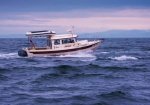I just read this article. The more you know....you know.
https://www.soundingsonline.com/news/seamanship
https://www.soundingsonline.com/news/seamanship
holds for going into the waves, but not when going down wind. Too much bow down trim will make the boat "bow steer" and tend to broach.Trim tabs: For most vessels, activating the trim tabs to fully “bow down” will help keep the wheels in the water and minimize cavitation. In addition, it will place more of your hull in the water. Generally, this will translate into smoother power transfer to the propellers, and better steerage and stability.
-->"• Steer the waves: Learn how to best snake your way through the wave pattern. A little well-timed helm input can make for a much smoother ride. Each boat and sea state are different, so again practice is important."
His statements are qualified with"...Typically, hulls with less beam and more deadrise will handle the rough stuff better than designs with wider, flatter bottoms."
For our C-Dorys this part is good advice: "You might want to consider a zigzag course, “powerboat tacking” if you will." which may be on every wave, depending on the size, type (breaking or not), and wind direction, (with or against the current). Often running parallel in the trough with beam seas can work but it is imperative to keep an eye on the oncoming wave and know when to jog over into the next trough. (called the Jog and Slog running style)."but this depends in large part on the boat’s characteristics."
He is speaking of high deadrise vessels and considering our C-Dorys will maintain plane at 9 or 10 knots, we have more steerage control at that speed than if we drop into displacement speed. We do not gain stability at displacement, and for running beam seas, that is a huge disadvantage for us. In head seas, speed is dependent on the wave steepness as in following seas. This is where there is frequent throttle work, to avoid slamming, and in following seas to avoid any bow steering, trim tabs must be in full up position, and tail heavy is a plus. the author does have a reminder in closing,"It is essential to remain in control of your vessel, (Dah, good point!! Emphasis mine.), and at reduced speed, there is more time to maneuver and react to seas. Also, the boat may fall into displacement mode so that more of it is in the water, improving stability."
"Keep in mind, however, that there is a point where too little speed can hamper maneuverability."

.1050 Hz Warning Alarm TONE ALERTS
NWS transmits an automated 1050 Hz tone that automatically activates compatible NWR receivers when a severe weather situation exists anywhere in the transmitter's coverage area. Many (but not all) NWR receivers incorporate this feature. Many VHF marine radiotelephones incorporate this feature, however some require an active NWR channel and using a non-scanning mode for the highest level of effectiveness. Therefore, NWS again recommends having a separate NWR receiver aboard to maintain a simultaneous watch on NWR and marine VHF channels.
